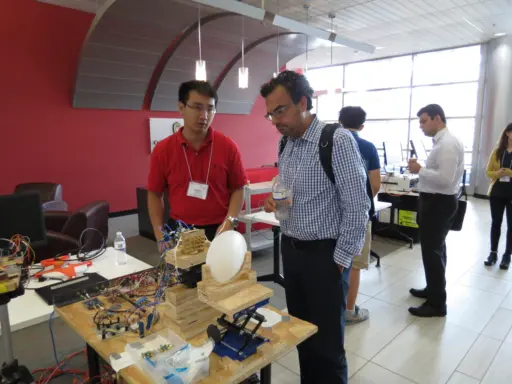The days of sluggish data speeds in crowded venues or areas are numbered. As demands of existing wireless systems reach capacity, University of Wisconsin-Madison researchers pave the way for the next generation of wireless systems—5G and beyond.
Existing wireless networks transmit signals in all directions and there is a limited amount of bandwidth for which people compete. The more people on a network, the slower the speed per person.
5G networks, on the other hand, will incorporate high-frequency millimeter-wave signals that can be directed to specific devices like lasers, which eliminates the need to share bandwidth.
“Instead of having to cut the pie into pieces, everyone can have a pie of their own,” says Akbar Sayeed, a professor of electrical and computer engineering at UW-Madison.
Despite the promise of faster speeds and lower latency, millimeter-wave wireless poses many practical challenges and requires an overhaul of existing wireless infrastructure. With experts in millimeter-wave hardware, communication and signal processing, and networking protocols, UW-Madison is a hub for cutting-edge millimeter-wave research and is working to solve these challenges.
 UW-Madison student Kevin Zhu shows millimeter-wave wireless steering committee member Ali Niknejad the CAP-MIMO 28GHz testbed from Sayeed’s lab. (Niknejad is from UC-Berkeley).
UW-Madison student Kevin Zhu shows millimeter-wave wireless steering committee member Ali Niknejad the CAP-MIMO 28GHz testbed from Sayeed’s lab. (Niknejad is from UC-Berkeley).Sayeed and fellow UW-Madison researchers are developing millimeter-wave technologies from the ground up, which allows them to innovate without the constraints of existing industrial hardware. For example, Sayeed develops lens arrays and new antenna architectures to form millimeter-wave beams, while colleagues Xinyu Zhang and Parmesh Ramanathan pioneer research on millimeter-wave wireless networking protocols. Sayeed and Zhang also are developing experimental millimeter-wave wireless platforms and testbeds at different frequency bands.
In addition, Sayeed and Ramanathan are working on a new collaborative project with colleagues at Washington State University to advance millimeter-wave wireless research. The project is funded by a $1.2 million National Science Foundation grant awarded in June 2017 and is aimed at addressing the hardware, signal processing, and networking challenges associated with steering and putting data into multiple signal beams at millimeter-wave frequencies. As a part of the project, Sayeed and Ramanathan will use a new millimeter-wave wireless testbed to test new communication protocols in real time. The testbed is based on a new multiple-input, multiple-output (MIMO) architecture, pioneered by Sayeed’s group, that uses lens arrays for increasing capacity by steering multiple beams to different users.
This funding comes about a year after the White House announced a seven-year, $400 million NSF initiative to enable next-generation wireless research and advance communication infrastructure nationwide. The initiative supports the cross-disciplinary millimeter-wave Research Coordination Network led by Sayeed and Zhang.
In July 2017, UW-Madison hosted a workshop for the Research Coordination Network, which brought stakeholders from academia, industry and government together to explore how to advance, develop and implement millimeter-wave wireless technologies for 5G and beyond. The workshop also featured demonstrations of the millimeter-wave platforms and testbeds being development at UW-Madison.
“It’s vital that we bring together people from academia, industry and government,” says Sayeed. “This is the future.”